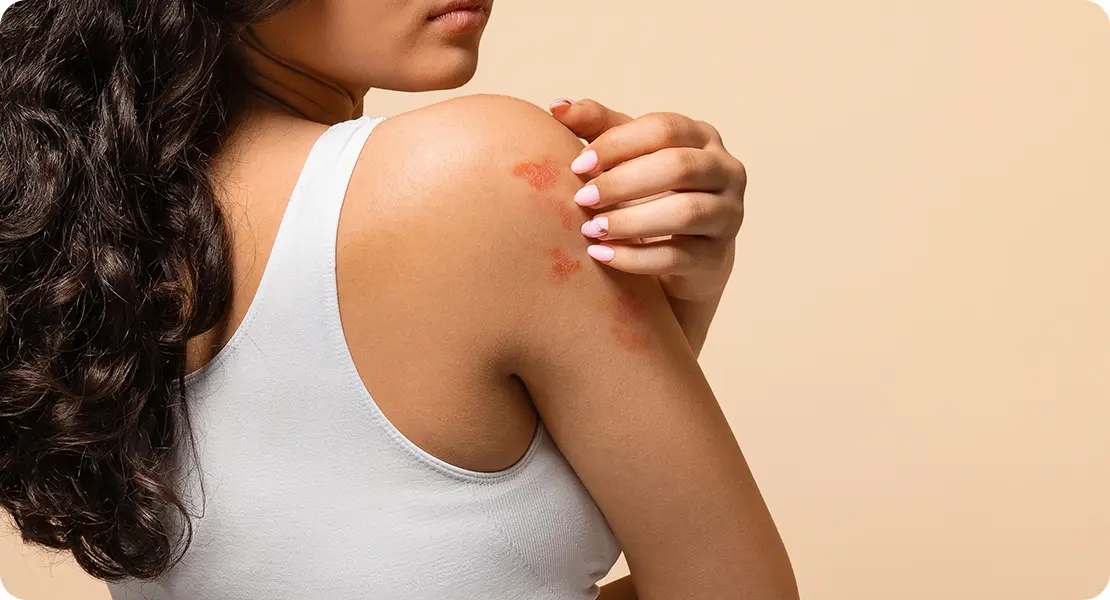Imagine this: you’ve finally committed to a good workout, whether it’s a brisk morning jog, a spin class, or even a simple warm-up at the gym. You’re motivated, energised, and ready to go. But just as your body starts to warm up, you suddenly notice an uncomfortable itching sensation spreading across your skin. For some, it’s a mild tickle that comes and goes. For others, it feels sharper like tiny pinpricks or stinging forcing you to scratch and sometimes even pause your workout.
If this sounds familiar, you’re not alone. Many people experience what’s often called exercise-induced itching, and it’s far more common than most of us realise. In fact, it’s such a widespread phenomenon that dermatologists and sports medicine experts have studied it to better understand why it happens. While it can feel distracting and, at times, concerning, the reassuring truth is that in the majority of cases, it’s harmless and temporary.
So why does it happen? The answer isn’t the same for everyone, because there are multiple factors at play. Sometimes, it’s simply the body’s natural response to increased blood circulation. When you begin to exercise, your heart pumps faster, your blood vessels expand to carry more oxygen, and the tiny capillaries in your skin open up. This sudden rush of activity can stimulate nerve endings near the surface of the skin, leading to that familiar prickly or itchy feeling.
Other times, the itch might be related to external factors such as sweat irritating sensitive skin, friction from tight workout clothes, or dry air that leaves your skin less hydrated. Even the type of fabric you wear matters synthetic materials that trap heat and moisture can make itching worse, while breathable fabrics often reduce it. Environmental conditions also play a role. For example, running outdoors in cold, dry weather or in pollen-heavy air can trigger itchiness that you might not notice when working out indoors.
In some cases, the culprit is linked to specific conditions. For instance, cholinergic urticaria, a type of heat-induced hives, can cause red, itchy welts to appear during exercise, especially when body temperature rises quickly. People with dry skin, eczema, or allergies may also find that exercise triggers flare-ups more easily. Although these situations are less common, they highlight how individual factors like skin type, health history, and environment combine to shape your experience.
What makes this kind of itching particularly frustrating is that it often appears right when you’re trying to do something positive for your health. Instead of focusing on your breathing, pace, or form, you find yourself distracted by scratching or shifting uncomfortably in your clothes. And for some, the irritation can be so strong that it discourages them from exercising regularly.
The encouraging news is that most of the time, exercise-induced itching isn’t something to worry about. With a better understanding of what’s happening in your body, you can often find simple solutions like adjusting your warm-up routine, staying hydrated, moisturising before exercise, or switching to lightweight, breathable clothing that make a big difference. In more persistent cases, a dermatologist can help identify whether an underlying skin condition or allergy is involved.
So, if you’ve been wondering why your skin seems to rebel every time you start a workout, you’re not imagining it. There are clear reasons why exercise can make you itch, and the more you understand about those causes, the easier it becomes to manage them and keep your workouts comfortable and enjoyable.
Common Causes of Exercise-Related Itching

Exercise-induced itching can be an annoying distraction, but understanding the underlying reasons can help you manage it effectively. There are several common causes, ranging from environmental triggers to individual skin sensitivities. Here’s a detailed look at some of the most frequent culprits:
- Heat Rash
Heat rash, also called miliaria, occurs when sweat becomes trapped under the skin instead of evaporating. This trapped sweat irritates the skin and leads to tiny, red, itchy bumps that can appear anywhere sweat tends to accumulate, such as the chest, back, underarms, or folds of the skin. Heat rash is particularly common during workouts in hot or humid conditions, or when wearing tight or non-breathable clothing. Fabrics that don’t allow airflow, like some synthetic materials, can worsen the problem, whereas moisture-wicking, breathable fabrics can help prevent it. People who are prone to heat rash may also notice that symptoms improve when they exercise in cooler environments or after gradually warming up. - Cholinergic Urticaria
Cholinergic urticaria is a type of hives triggered by a sudden rise in body temperature. It commonly appears during vigorous exercise, hot showers, or even moments of emotional stress. Those affected often see small, raised, red, and intensely itchy bumps forming on areas such as the chest, arms, or back. The reaction can last anywhere from a few minutes to several hours, and scratching typically worsens the discomfort. Managing cholinergic urticaria may involve strategies such as a gradual warm-up, cooling down immediately after exercise, or consulting a dermatologist for personalised treatment options. - Dry Skin
Dry skin can make exercise-induced itching more pronounced. Frequent showers, harsh soaps, or naturally low skin moisture levels can compromise the skin barrier. When this barrier is weakened, sweat irritates the skin rather than helping regulate temperature, causing persistent itchiness. Dry skin often affects the limbs and torso, and symptoms can worsen in winter or dry indoor environments. Regular moisturising, using gentle cleansers, and avoiding very hot showers can help protect the skin and reduce irritation during workouts. - Allergic Reactions
Allergies can also play a role in exercise-related itching. Some people react to fabrics, laundry detergents, or environmental allergens like pollen and dust. Even minor irritants in sportswear can trigger redness, bumps, or itching. People with known sensitivities may need to experiment with hypoallergenic detergents, different clothing materials, or choose cleaner outdoor locations to reduce exposure to potential allergens. In some cases, antihistamines or dermatologist-recommended treatments can provide relief before and after exercise. - Increased Blood Flow and Nerve Stimulation
Another reason your skin may itch during exercise is increased blood circulation. When you start moving, your heart rate rises, and blood vessels expand to deliver more oxygen and nutrients to muscles. This sudden surge in blood flow can stimulate nerve endings near the skin’s surface, creating a tingling or itchy sensation. While this reaction is harmless, it can be surprising for first-time exercisers or those returning after a break. Gradually easing into exercise and warming up slowly can help reduce the intensity of this response. - Friction and Chafing
Physical activity often involves repeated movements that create friction between your skin and clothing or between skin folds. Over time, this friction can irritate the skin, causing redness, tiny bumps, and itching. Areas commonly affected include the inner thighs, underarms, and around sports bra straps or waistband lines. Wearing properly fitting, moisture-wicking clothing and applying protective balms or powders in high-friction areas can help minimise discomfort. - Environmental Factors
Finally, environmental conditions can amplify exercise-related itching. Hot, humid weather increases sweat production, dry indoor air can exacerbate dryness, and outdoor allergens like pollen or pollution can irritate sensitive skin. Even temperature swings such as moving from a cold environment into a heated gym can provoke itchiness. Paying attention to where and when you exercise, and adjusting your routine accordingly, can make a significant difference.
When to See a Dermatologist

It’s perfectly normal to experience occasional itching during or after exercise, especially if it’s mild and goes away quickly once your body cools down. Many people brush it off as a temporary nuisance caused by sweat, friction, or heat. However, there are times when this itchiness could be a sign of something more significant. If your symptoms are persistent, severe, or affecting your quality of life, it’s important to seek professional advice from a dermatologist. These specialists can accurately diagnose the cause of your symptoms whether it’s a temporary reaction to exercise, a heat-related rash, an allergic response, or a chronic skin condition such as cholinergic urticaria or eczema. Early intervention can prevent complications, provide effective relief, and help you continue your exercise routine safely.
You should consider consulting a dermatologist if you notice any of the following warning signs:
- Itching that affects sleep or daily activities: If the itchiness is strong enough to disrupt your concentration during workouts, interfere with your work or study, or prevent you from sleeping comfortably, it may indicate an underlying skin issue that needs attention. Persistent itching can also lead to repeated scratching, which may cause skin damage, infections, or scarring over time.
- Hives, swelling, or severe redness: The appearance of raised welts, significant swelling, or intense redness is not typical of ordinary post-exercise itching. These symptoms may indicate a more serious reaction, such as an allergy, heat-induced hives, or a dermatological condition that requires treatment. For example, cholinergic urticaria often causes small, itchy bumps accompanied by redness and, in some cases, mild swelling.
- Symptoms that appear with minimal exercise or at rest: If your skin starts itching even with light activity or sometimes without any physical exertion at all it could suggest a more chronic or systemic condition. This is particularly concerning if the itching is accompanied by other symptoms, such as dizziness, shortness of breath, or widespread skin reactions. A dermatologist can help determine whether these reactions are related to exercise, an environmental trigger, or an underlying health issue.
- Recurring or worsening symptoms: If the itchiness comes back repeatedly or seems to be getting worse over time, it’s a good idea to seek professional advice. Chronic irritation may indicate conditions such as eczema, psoriasis, or other inflammatory skin disorders, all of which benefit from early diagnosis and proper management.
When you visit a dermatologist, they will usually start with a thorough physical examination and ask detailed questions about your medical history, lifestyle, and exercise habits. Depending on the situation, they may recommend additional tests, such as allergy testing, blood tests, or skin biopsies, to pinpoint the exact cause. Once a diagnosis is made, the dermatologist can develop a personalised treatment plan that may include topical creams, moisturisers, antihistamines, or other medications, along with lifestyle adjustments to reduce triggers and prevent flare-ups.
Seeking professional guidance not only provides relief but also ensures that your exercise routine can continue safely and comfortably. With the right strategies in place, you can enjoy physical activity without worrying about persistent itching, irritation, or skin damage. Consulting a dermatologist is an important step toward maintaining both your skin health and your overall well-being.
Tips to Reduce Exercise-Related Itching
Exercise-induced itching can be frustrating, but there are several strategies you can use to reduce discomfort and make your workouts more enjoyable. Small adjustments to your clothing, skincare, and exercise habits often make a big difference. Here are some effective tips:
- Wear breathable fabrics
Choosing the right workout clothing is one of the most important steps to prevent exercise-related itching. Moisture-wicking fabrics, such as polyester blends or technical sportswear materials, help pull sweat away from the skin, keeping it dry and reducing irritation. Avoid tight, non-breathable materials, which can trap sweat and increase friction. Opt for loose-fitting clothing in areas prone to sweating, such as the underarms, back, and thighs, to minimise chafing and heat build-up. - Shower promptly after exercise
Sweat, dirt, and bacteria can accumulate on the skin during workouts, increasing the risk of itching and irritation. Showering promptly after exercise helps remove these irritants. Use lukewarm water rather than hot water, as very hot showers can strip natural oils from the skin and worsen dryness. Gentle, fragrance-free cleansers are ideal, as harsh soaps can disrupt the skin barrier and make itching more likely. - Moisturise regularly
Keeping your skin hydrated is key to preventing post-exercise itching, especially if you have naturally dry skin. Applying a fragrance-free moisturiser after showering helps restore the skin barrier and reduce irritation caused by sweat or friction. For those prone to extreme dryness, using a thicker cream or ointment in problem areas, such as arms, legs, or torso, can provide extra protection. Moisturising before exercise can also help prevent friction-related irritation in some cases. - Stay cool during workouts
Excessive heat can trigger itching, especially in people prone to heat rash or cholinergic urticaria. Exercising in well-ventilated spaces, using fans, or working out in cooler environments can help regulate body temperature and reduce the risk of skin irritation. Taking short breaks to cool down, wearing breathable layers that can be removed as you warm up, and avoiding outdoor exercise in extreme heat or humidity are also effective strategies. - Patch test skincare and laundry products
Some itching may result from reactions to new skincare products, deodorants, or laundry detergents. Fragrances, dyes, and harsh chemicals can all irritate the skin, especially when combined with sweat and friction. Before using a new product on your body or clothing, perform a patch test on a small area of skin to check for reactions. Switching to hypoallergenic, fragrance-free options can help prevent flare-ups during and after exercise. - Warm up gradually
Starting exercise suddenly at high intensity can increase blood flow and trigger nerve endings in the skin, which sometimes causes itching. Incorporating a gradual warm-up such as light stretching, brisk walking, or gentle movement for five to ten minutes can allow your body to adjust to increased circulation and temperature, reducing the likelihood of sudden itchiness. - Stay hydrated
Dehydration can contribute to dry skin, making it more prone to irritation during exercise. Drinking adequate water before, during, and after your workout helps maintain skin hydration and supports overall body function, including temperature regulation. - Consider topical protective products
For areas prone to friction or repeated irritation, applying a thin layer of petroleum jelly or a sports-specific anti-chafing balm can create a protective barrier between the skin and clothing. This can reduce itching caused by rubbing and sweat accumulation, especially during long workouts or high-intensity activities.
By implementing these strategies, most people can significantly reduce or even eliminate exercise-related itching. Paying attention to clothing choices, skincare routines, hydration, and exercise environment helps ensure that your workouts are not only effective but also comfortable and itch-free.
Final Thought: Managing Exercise-Induced Itching
Exercise-induced itching can be frustrating, but understanding the underlying causes makes it easier to manage. Whether it’s heat rash, dry skin, or a more specific condition like cholinergic urticaria, a personalised approach works best.
If your symptoms persist or worsen, you can book a consultation with a dermatologist in London for professional assessment and tailored treatment.
References:
- Castells, M. (2020) ‘Clinical Management of Exercise-Induced Anaphylaxis and Urticaria’, Journal of Allergy and Clinical Immunology: In Practice, 8(6), pp. 1909–1918. Available at: https://www.jaci-inpractice.org/article/S2213-2198%2820%2930065-9/abstract
- Allergy & Asthma Network. (2023) Eczema and Exercise. Available at: https://allergyasthmanetwork.org/news/eczema-and-exercise/
- Komarow, H.D., Baker, J.R., et al. (2022) ‘Cholinergic Urticaria: Subtype Classification and Clinical Management’, Journal of Clinical Medicine, 11(18), 5321. doi: 10.3390/jcm11185321. Available at: https://www.ncbi.nlm.nih.gov/pmc/articles/PMC9476404/
